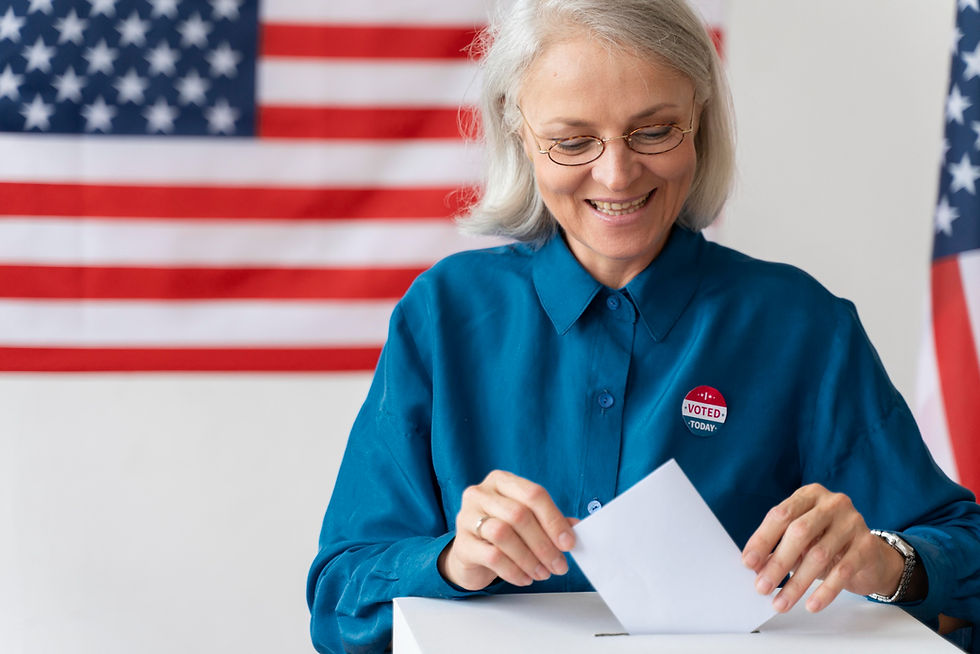Stay Strong, Flexible and Balanced with Exercise (MAY IS OLDER AMERICAN’S MONTH – WEEK #3)
- Ohio Center for Hope

- May 12
- 4 min read
MAY IS OLDER AMERICAN’S MONTH – WEEK #3

Much of life is a balancing act…from learning to sit up as an infant through avoiding falls in the later years. Balance is the ability to distribute your weight in a way that enables you to remain upright and steady. This requires multiple systems in your body to be working in sync with your brain, including: the central nervous system (spinal cord), the vestibular system (inner ear), the visual system (eyes), as well as position-sensing nerves, muscles and bones.
While balance is important at every stage of life, changes associated with aging such as weaker, more inflexible muscles, slower reflexes, worsening eyesight and fewer cells in the vestibular system can affect your balance. Inner ear disorders, Parkinson’s disease, stroke, neuropathy and dips in blood pressure can also impact balance. According to the Centers for Disease Control and Prevention, at least one out of every three people over 65 experiences a fall each year.
The good news is that a wide variety of exercises, from weight training and aerobics to simple daily walks, can help you maintain and significantly improve balance as you age. A consistent regimen of training rehabilitates and strengthens muscles and improves stability and postural alignment. The benefits extend to a person’s emotional and psychological well-being. According to experts, “fear of falling” is ironically one of the biggest predictors of a fall, and faithful adherence to an exercise routine that includes balance-specific training replaces the fear with confidence.
A program to improve balance does not need to be complicated. Begin slowly with regular walks, and try simple exercises such as balancing on one foot or following along with a guided routine on a DVD. More targeted balance training may be done at a fitness center or through the use of a personal trainer or physical therapist. Professionals can assist you in conditioning the core—the set of muscles, bones and joints that link the upper and lower body and enable you to bend, twist, rotate or stand in one spot without losing your balance. An effective core workout may include exercises such as squats, lunges, twists and ab crunches. Exercise experts also can introduce you to the use of specific equipment to challenge you while improving your balance, such as a BOSU (both sides utilized) balance trainer, a stability ball, or standing on a spongy, unstable surface.

Pilates, yoga, and the ancient Chinese art of tai chi, are also excellent for improving balance and core strength. Tai chi combines meditation with slow, graceful movements and deep breathing and relaxation, helping people achieve an inner serenity. This approach benefits both mind and body, shown in multiple studies to: build up bones, stabilize joints, lower blood pressure and heart rate, bolster cardiovascular health and immunity, enhance quality of sleep, reduce stress and enhance mood. Practicing tai chi has been shown to reduce falls in seniors by up to 45 percent, and has proven effective in helping people with Parkinson’s disease achieve better balance.
A fall can occur anywhere at any time at any age. Therefore, the importance of body balance in one’s daily life should not be minimized. The American College of Sports Medicine recommends a program that combines strength, balance, flexibility and endurance. Explore one of these options you believe may work for you.
Here's why Tai Chi is a great option for seniors:
Improved Balance and Stability: Tai Chi's slow, controlled movements and focus on breathing help improve balance and reduce the risk of falls.
Increased Flexibility and Range of Motion: The exercises help to loosen muscles and joints, improving flexibility and overall mobility.
Enhanced Strength: While low-impact, Tai Chi can also help build muscle strength and endurance.
Stress Relief and Mental Clarity: The mindful movements and deep breathing in Tai Chi can help reduce stress and improve mental focus.
Low Impact: Tai Chi is a gentle form of exercise that is easy on the joints, making it suitable for seniors with arthritis or other joint issues.
Social Interaction: Classes can be a great way for seniors to socialize and connect with others.
Where to find Tai Chi classes for seniors:
Some Local Senior Centers: Many senior centers offer Tai Chi classes, often free or at a low cost.
Community Centers: Check your local community center for Tai Chi classes or workshops.
SilverSneakers Programs: Some Medicare Advantage plans include SilverSneakers, which provides access to fitness programs like Tai Chi at participating locations
Online Classes: If in-person classes are not an option, many online Tai Chi programs are available, search YouTube.com or your favorite online video source for classes.
Tips for getting started:
Consult your doctor: Before starting any new exercise routine, it's always a good idea to check with your doctor.
Start slowly: Beginners should start with gentle movements and gradually increase the intensity.
Find a qualified instructor: Look for a certified Tai Chi instructor who is experienced in teaching seniors.
Be patient: It takes time to see results from Tai Chi practice, so be patient and consistent.
Source: Some of this content was derived from https://kavitawillesenmd.com/tipping-point-stay-strong-flexible-and-balanced-with-exercise/
The Ohio Center for Hope is a non-profit agency that provides mental health screenings,
operates a memory clinic with memory screenings, and arranges for community-based
referrals when needed. We strive to end the stigma around mental health, raise awareness
that early detection CAN slow the progression of memory loss, and empower our patients to
live healthy lives. OUR SERVICES ARE COMPLETELY FREE AND INSURANCE IS NEVER
NEEDED. . Local transportation may be available.


Ohio Center for Hope
Toll Free: 833-767-HOPE
8312 Cleveland Ave NW
North Canton, OH 44720





Comments